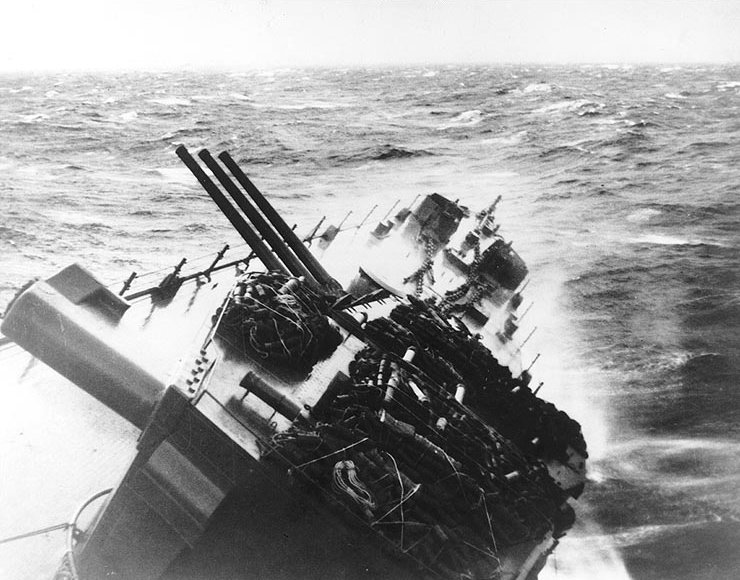Typhoon Cobra, also known as ‘Halsey’s Typhoon’ or ‘Typhoon of 1944’, was a devastating natural disaster that caught the United States Navy’s Task Force 38 off guard in the Western Pacific during World War II.
The typhoon, with fierce winds exceeding 100 miles per hour and enormous seas, resulted in the loss of three destroyers, significant damage to other ships, and nearly 800 lives.
Background
Task Force 38, a critical component of the U.S. Navy’s power projection in the Pacific during World War II, was a formidable assembly of naval might.
Under the operational control of the U.S. Third Fleet, it was led by Admiral William Halsey, a distinguished and aggressive commander known for his bold strategies.
The task force was primarily composed of 7 fleet carriers and 6 light carriers, which were the centerpiece of its offensive capabilities.
Alongside these carriers were a supporting cast of 8 battleships, 15 cruisers, and 50 destroyers, forming a balanced and powerful naval strike group.
The primary role of Task Force 38 was to conduct offensive operations against Japanese forces.
This included launching air strikes against enemy positions, supporting amphibious landings, engaging enemy fleets, and maintaining sea control in contested areas.
The task force was instrumental in several critical campaigns in the Pacific, including the Battle of Leyte Gulf and the Philippines campaign.
 Around 146 planes were lost during the Typhoon. Here, a view of USS Cowpen’s flight deck during the storm.
Around 146 planes were lost during the Typhoon. Here, a view of USS Cowpen’s flight deck during the storm.
The Pacific Theater of World War II was a vast and complex area of operations, stretching across millions of square miles of ocean.
It was characterized by a multitude of islands and atolls, each holding strategic value for control of the region.
The U.S. strategy in the Pacific involved island hopping, capturing specific islands to use as bases for advancing closer to Japan.
The Pacific is known for its volatile weather patterns, including powerful typhoons (tropical cyclones) that can arise suddenly and with devastating force.
Navigating these conditions required not only skilled seamanship but also reliable weather forecasting, which during World War II was still in its nascent stages.
For naval operations, particularly for a fleet as large and complex as Task Force 38, understanding and predicting weather conditions was crucial.
Aircraft carrier operations are especially sensitive to weather conditions, as high winds and rough seas can hinder flight operations, risking both aircraft and crew.
In this backdrop, Typhoon Cobra struck Task Force 38 in December 1944.
The task force, heavily engaged in operations against Japan and operating under the constant threat of attack, now faced a new and unpredictable enemy in the form of a natural disaster.
Typhoon Cobra Hits
In early December 1944, Task Force 38, while executing its mission in the Philippine Sea, faced an unexpected challenge.
The force, under the command of Admiral William Halsey, was conducting intensive operations, including air strikes against Japanese airfields in support of the Mindoro landing operations.
On December 17, Task Force 38 encountered a severe tropical storm that would later be identified as Typhoon Cobra.
 USS Santa Fe leaning to starboard during Typhoon Cobra.
USS Santa Fe leaning to starboard during Typhoon Cobra.
Typhoon Cobra was a massive and powerful storm, categorized as a Category 4 typhoon.
It brought with it extremely high winds, around 160 miles per hour, and towering waves that posed a catastrophic threat to naval operations.
The ferocity of the storm was unprecedented in the experience of Task Force 38.
The ships, particularly the smaller destroyers, were ill-equipped to handle such severe conditions.
Aircraft carriers, with their exposed flight decks, faced immense challenges as the storm wreaked havoc on the parked aircraft.
Aftermath of the Typhoon
The impact of Typhoon Cobra on Task Force 38 was catastrophic.
Three destroyers, USS Hull, USS Spence, and USS Monaghan, were lost to the storm, capsizing under the overwhelming power of the typhoon.
 The bow of USS Maddox completely submerged during the storm.
The bow of USS Maddox completely submerged during the storm.
Many other ships in the task force suffered significant damage.
The storm’s impact was not limited to material losses; it also had a profound effect on the personnel.
The violent seas and fierce winds endangered everyone on board, leading to significant loss of life.
Nearly 800 sailors lost their lives, and many others were injured.
The incident also necessitated a period of regrouping and repair for Task Force 38, as it counted the material and human cost of the typhoon.





